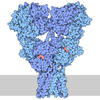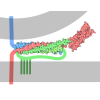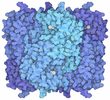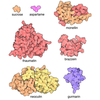[English] 日本語
 Yorodumi
Yorodumi- EMDB-13969: Active state of GluA1/2 in complex with TARP gamma 8, L-glutamate... -
+ Open data
Open data
- Basic information
Basic information
| Entry | Database: EMDB / ID: EMD-13969 | ||||||||||||
|---|---|---|---|---|---|---|---|---|---|---|---|---|---|
| Title | Active state of GluA1/2 in complex with TARP gamma 8, L-glutamate and CTZ | ||||||||||||
 Map data Map data | Postprocessed map obtained in Relion | ||||||||||||
 Sample Sample |
| ||||||||||||
 Keywords Keywords | glutamate / AMPA receptor / TARPs / MEMBRANE PROTEIN | ||||||||||||
| Function / homology |  Function and homology information Function and homology informationPhase 0 - rapid depolarisation / Phase 2 - plateau phase / Cargo concentration in the ER / cellular response to amine stimulus / axonal spine / COPII-mediated vesicle transport / positive regulation of membrane potential / positive regulation of locomotion involved in locomotory behavior / cellular response to ammonium ion / neurotransmitter receptor activity involved in regulation of postsynaptic cytosolic calcium ion concentration ...Phase 0 - rapid depolarisation / Phase 2 - plateau phase / Cargo concentration in the ER / cellular response to amine stimulus / axonal spine / COPII-mediated vesicle transport / positive regulation of membrane potential / positive regulation of locomotion involved in locomotory behavior / cellular response to ammonium ion / neurotransmitter receptor activity involved in regulation of postsynaptic cytosolic calcium ion concentration / neurotransmitter receptor transport, postsynaptic endosome to lysosome / neurotransmitter receptor internalization / response to sucrose / proximal dendrite / L-type voltage-gated calcium channel complex / LGI-ADAM interactions / myosin V binding / Trafficking of AMPA receptors / neuron spine / cellular response to L-glutamate / regulation of AMPA receptor activity / protein phosphatase 2B binding / regulation of monoatomic ion transmembrane transport / conditioned place preference / postsynaptic neurotransmitter receptor diffusion trapping / response to arsenic-containing substance / cellular response to dsRNA / dendritic spine membrane / Synaptic adhesion-like molecules / beta-2 adrenergic receptor binding / long-term synaptic depression / cellular response to peptide hormone stimulus / response to morphine / protein kinase A binding / neuronal cell body membrane / peptide hormone receptor binding / spine synapse / dendritic spine neck / response to psychosocial stress / spinal cord development / dendritic spine head / Activation of AMPA receptors / perisynaptic space / AMPA glutamate receptor activity / channel regulator activity / transmission of nerve impulse / ligand-gated monoatomic cation channel activity / Trafficking of GluR2-containing AMPA receptors / response to lithium ion / immunoglobulin binding / behavioral response to pain / AMPA glutamate receptor complex / kainate selective glutamate receptor activity / adenylate cyclase binding / regulation of postsynaptic membrane neurotransmitter receptor levels / ionotropic glutamate receptor complex / cellular response to glycine / extracellularly glutamate-gated ion channel activity / : / positive regulation of excitatory postsynaptic potential / excitatory synapse / asymmetric synapse / regulation of postsynaptic membrane potential / regulation of receptor recycling / calcium channel regulator activity / G-protein alpha-subunit binding / Unblocking of NMDA receptors, glutamate binding and activation / long-term memory / voltage-gated calcium channel activity / positive regulation of synaptic transmission / glutamate receptor binding / postsynaptic density, intracellular component / neuronal action potential / extracellular ligand-gated monoatomic ion channel activity / response to electrical stimulus / glutamate-gated receptor activity / synapse assembly / regulation of synaptic transmission, glutamatergic / response to fungicide / dendrite membrane / presynaptic active zone membrane / glutamate-gated calcium ion channel activity / ionotropic glutamate receptor binding / somatodendritic compartment / cellular response to brain-derived neurotrophic factor stimulus / cytoskeletal protein binding / ligand-gated monoatomic ion channel activity involved in regulation of presynaptic membrane potential / dendrite cytoplasm / ionotropic glutamate receptor signaling pathway / positive regulation of synaptic transmission, glutamatergic / SNARE binding / dendritic shaft / synaptic transmission, glutamatergic / transmitter-gated monoatomic ion channel activity involved in regulation of postsynaptic membrane potential / PDZ domain binding / protein tetramerization / long-term synaptic potentiation / response to cocaine / cellular response to amino acid stimulus / synaptic membrane Similarity search - Function | ||||||||||||
| Biological species |  | ||||||||||||
| Method | single particle reconstruction / cryo EM / Resolution: 3.5 Å | ||||||||||||
 Authors Authors | Herguedas B / Kohegyi B | ||||||||||||
| Funding support |  Spain, 3 items Spain, 3 items
| ||||||||||||
 Citation Citation |  Journal: Nat Commun / Year: 2022 Journal: Nat Commun / Year: 2022Title: Mechanisms underlying TARP modulation of the GluA1/2-γ8 AMPA receptor. Authors: Beatriz Herguedas / Bianka K Kohegyi / Jan-Niklas Dohrke / Jake F Watson / Danyang Zhang / Hinze Ho / Saher A Shaikh / Remigijus Lape / James M Krieger / Ingo H Greger /     Abstract: AMPA-type glutamate receptors (AMPARs) mediate rapid signal transmission at excitatory synapses in the brain. Glutamate binding to the receptor's ligand-binding domains (LBDs) leads to ion channel ...AMPA-type glutamate receptors (AMPARs) mediate rapid signal transmission at excitatory synapses in the brain. Glutamate binding to the receptor's ligand-binding domains (LBDs) leads to ion channel activation and desensitization. Gating kinetics shape synaptic transmission and are strongly modulated by transmembrane AMPAR regulatory proteins (TARPs) through currently incompletely resolved mechanisms. Here, electron cryo-microscopy structures of the GluA1/2 TARP-γ8 complex, in both open and desensitized states (at 3.5 Å), reveal state-selective engagement of the LBDs by the large TARP-γ8 loop ('β1'), elucidating how this TARP stabilizes specific gating states. We further show how TARPs alter channel rectification, by interacting with the pore helix of the selectivity filter. Lastly, we reveal that the Q/R-editing site couples the channel constriction at the filter entrance to the gate, and forms the major cation binding site in the conduction path. Our results provide a mechanistic framework of how TARPs modulate AMPAR gating and conductance. | ||||||||||||
| History |
|
- Structure visualization
Structure visualization
| Movie |
 Movie viewer Movie viewer |
|---|---|
| Structure viewer | EM map:  SurfView SurfView Molmil Molmil Jmol/JSmol Jmol/JSmol |
| Supplemental images |
- Downloads & links
Downloads & links
-EMDB archive
| Map data |  emd_13969.map.gz emd_13969.map.gz | 10.5 MB |  EMDB map data format EMDB map data format | |
|---|---|---|---|---|
| Header (meta data) |  emd-13969-v30.xml emd-13969-v30.xml emd-13969.xml emd-13969.xml | 25.7 KB 25.7 KB | Display Display |  EMDB header EMDB header |
| FSC (resolution estimation) |  emd_13969_fsc.xml emd_13969_fsc.xml | 11.4 KB | Display |  FSC data file FSC data file |
| Images |  emd_13969.png emd_13969.png | 48.3 KB | ||
| Filedesc metadata |  emd-13969.cif.gz emd-13969.cif.gz | 8.1 KB | ||
| Others |  emd_13969_additional_1.map.gz emd_13969_additional_1.map.gz emd_13969_half_map_1.map.gz emd_13969_half_map_1.map.gz emd_13969_half_map_2.map.gz emd_13969_half_map_2.map.gz | 4.8 MB 97 MB 97 MB | ||
| Archive directory |  http://ftp.pdbj.org/pub/emdb/structures/EMD-13969 http://ftp.pdbj.org/pub/emdb/structures/EMD-13969 ftp://ftp.pdbj.org/pub/emdb/structures/EMD-13969 ftp://ftp.pdbj.org/pub/emdb/structures/EMD-13969 | HTTPS FTP |
-Validation report
| Summary document |  emd_13969_validation.pdf.gz emd_13969_validation.pdf.gz | 715.6 KB | Display |  EMDB validaton report EMDB validaton report |
|---|---|---|---|---|
| Full document |  emd_13969_full_validation.pdf.gz emd_13969_full_validation.pdf.gz | 715.2 KB | Display | |
| Data in XML |  emd_13969_validation.xml.gz emd_13969_validation.xml.gz | 18.6 KB | Display | |
| Data in CIF |  emd_13969_validation.cif.gz emd_13969_validation.cif.gz | 24.2 KB | Display | |
| Arichive directory |  https://ftp.pdbj.org/pub/emdb/validation_reports/EMD-13969 https://ftp.pdbj.org/pub/emdb/validation_reports/EMD-13969 ftp://ftp.pdbj.org/pub/emdb/validation_reports/EMD-13969 ftp://ftp.pdbj.org/pub/emdb/validation_reports/EMD-13969 | HTTPS FTP |
-Related structure data
| Related structure data |  7qhbMC  7qhhC M: atomic model generated by this map C: citing same article ( |
|---|---|
| Similar structure data |
- Links
Links
| EMDB pages |  EMDB (EBI/PDBe) / EMDB (EBI/PDBe) /  EMDataResource EMDataResource |
|---|---|
| Related items in Molecule of the Month |
- Map
Map
| File |  Download / File: emd_13969.map.gz / Format: CCP4 / Size: 125 MB / Type: IMAGE STORED AS FLOATING POINT NUMBER (4 BYTES) Download / File: emd_13969.map.gz / Format: CCP4 / Size: 125 MB / Type: IMAGE STORED AS FLOATING POINT NUMBER (4 BYTES) | ||||||||||||||||||||||||||||||||||||||||||||||||||||||||||||
|---|---|---|---|---|---|---|---|---|---|---|---|---|---|---|---|---|---|---|---|---|---|---|---|---|---|---|---|---|---|---|---|---|---|---|---|---|---|---|---|---|---|---|---|---|---|---|---|---|---|---|---|---|---|---|---|---|---|---|---|---|---|
| Annotation | Postprocessed map obtained in Relion | ||||||||||||||||||||||||||||||||||||||||||||||||||||||||||||
| Projections & slices | Image control
Images are generated by Spider. | ||||||||||||||||||||||||||||||||||||||||||||||||||||||||||||
| Voxel size | X=Y=Z: 1.06 Å | ||||||||||||||||||||||||||||||||||||||||||||||||||||||||||||
| Density |
| ||||||||||||||||||||||||||||||||||||||||||||||||||||||||||||
| Symmetry | Space group: 1 | ||||||||||||||||||||||||||||||||||||||||||||||||||||||||||||
| Details | EMDB XML:
CCP4 map header:
| ||||||||||||||||||||||||||||||||||||||||||||||||||||||||||||
-Supplemental data
-Additional map: Composite map generated from focused refinement of TMD and LBD layers
| File | emd_13969_additional_1.map | ||||||||||||
|---|---|---|---|---|---|---|---|---|---|---|---|---|---|
| Annotation | Composite map generated from focused refinement of TMD and LBD layers | ||||||||||||
| Projections & Slices |
| ||||||||||||
| Density Histograms |
-Half map: Half map 2
| File | emd_13969_half_map_1.map | ||||||||||||
|---|---|---|---|---|---|---|---|---|---|---|---|---|---|
| Annotation | Half map 2 | ||||||||||||
| Projections & Slices |
| ||||||||||||
| Density Histograms |
-Half map: Half map 1
| File | emd_13969_half_map_2.map | ||||||||||||
|---|---|---|---|---|---|---|---|---|---|---|---|---|---|
| Annotation | Half map 1 | ||||||||||||
| Projections & Slices |
| ||||||||||||
| Density Histograms |
- Sample components
Sample components
-Entire : Complex between GluA1/2 AMPA receptor and auxiliary subunit TARP ...
| Entire | Name: Complex between GluA1/2 AMPA receptor and auxiliary subunit TARP gamma8 |
|---|---|
| Components |
|
-Supramolecule #1: Complex between GluA1/2 AMPA receptor and auxiliary subunit TARP ...
| Supramolecule | Name: Complex between GluA1/2 AMPA receptor and auxiliary subunit TARP gamma8 type: complex / ID: 1 / Parent: 0 / Macromolecule list: #1-#3 Details: GluA2 and TARP8 are expressed as a tandem construct |
|---|---|
| Source (natural) | Organism:  |
| Molecular weight | Theoretical: 490 KDa |
-Macromolecule #1: Isoform Flip of Glutamate receptor 1
| Macromolecule | Name: Isoform Flip of Glutamate receptor 1 / type: protein_or_peptide / ID: 1 / Number of copies: 2 / Enantiomer: LEVO |
|---|---|
| Source (natural) | Organism:  |
| Molecular weight | Theoretical: 102.66193 KDa |
| Recombinant expression | Organism:  Homo sapiens (human) Homo sapiens (human) |
| Sequence | String: MPYIFAFFCT GFLGAVVGAD YKDDDDKNFP NNIQIGGLFP NQQSQEHAAF RFALSQLTEP PKLLPQIDIV NISDSFEMTY RFCSQFSKG VYAIFGFYER RTVNMLTSFC GALHVCFITP SFPVDTSNQF VLQLRPELQE ALISIIDHYK WQTFVYIYDA D RGLSVLQR ...String: MPYIFAFFCT GFLGAVVGAD YKDDDDKNFP NNIQIGGLFP NQQSQEHAAF RFALSQLTEP PKLLPQIDIV NISDSFEMTY RFCSQFSKG VYAIFGFYER RTVNMLTSFC GALHVCFITP SFPVDTSNQF VLQLRPELQE ALISIIDHYK WQTFVYIYDA D RGLSVLQR VLDTAAEKNW QVTAVNILTT TEEGYRMLFQ DLEKKKERLV VVDCESERLN AILGQIVKLE KNGIGYHYIL AN LGFMDID LNKFKESGAN VTGFQLVNYT DTIPARIMQQ WRTSDSRDHT RVDWKRPKYT SALTYDGVKV MAEAFQSLRR QRI DISRRG NAGDCLANPA VPWGQGIDIQ RALQQVRFEG LTGNVQFNEK GRRTNYTLHV IEMKHDGIRK IGYWNEDDKF VPAA TDAQA GGDNSSVQNR TYIVTTILED PYVMLKKNAN QFEGNDRYEG YCVELAAEIA KHVGYSYRLE IVSDGKYGAR DPDTK AWNG MVGELVYGRA DVAVAPLTIT LVREEVIDFS KPFMSLGISI MIKKPQKSKP GVFSFLDPLA YEIWMCIVFA YIGVSV VLF LVSRFSPYEW HSEEFEEGRD QTTSDQSNEF GIFNSLWFSL GAFMQQGCDI SPRSLSGRIV GGVWWFFTLI IISSYTA NL AAFLTVERMV SPIESAEDLA KQTEIAYGTL EAGSTKEFFR RSKIAVFEKM WTYMKSAEPS VFVRTTEEGM IRVRKSKG K YAYLLESTMN EYIEQRKPCD TMKVGGNLDS KGYGIATPKG SALRGPVNLA VLKLSEQGVL DKLKSKWWYD KGECGSKDS GSKDKTSALS LSNVAGVFYI LIGGLGLAML VALIEFCYKS RSESKRMKGF CLIPQQSINE AIRTSTLPRN SGAGASGGGG SGENGRVVS QDFPKSMQSI PCMSHSSGMP LGATGL UniProtKB: Glutamate receptor 1 |
-Macromolecule #2: Isoform Flip of Glutamate receptor 2
| Macromolecule | Name: Isoform Flip of Glutamate receptor 2 / type: protein_or_peptide / ID: 2 / Number of copies: 2 / Enantiomer: LEVO |
|---|---|
| Source (natural) | Organism:  |
| Molecular weight | Theoretical: 96.247055 KDa |
| Recombinant expression | Organism:  Homo sapiens (human) Homo sapiens (human) |
| Sequence | String: MQKIMHISVL LSPVLWGLIF GVSSNSIQIG GLFPRGADQE YSAFRVGMVQ FSTSEFRLTP HIDNLEVANS FAVTNAFCSQ FSRGVYAIF GFYDKKSVNT ITSFCGTLHV SFITPSFPTD GTHPFVIQMR PDLKGALLSL IEYYQWDKFA YLYDSDRGLS T LQAVLDSA ...String: MQKIMHISVL LSPVLWGLIF GVSSNSIQIG GLFPRGADQE YSAFRVGMVQ FSTSEFRLTP HIDNLEVANS FAVTNAFCSQ FSRGVYAIF GFYDKKSVNT ITSFCGTLHV SFITPSFPTD GTHPFVIQMR PDLKGALLSL IEYYQWDKFA YLYDSDRGLS T LQAVLDSA AEKKWQVTAI NVGNINNDKK DETYRSLFQD LELKKERRVI LDCERDKVND IVDQVITIGK HVKGYHYIIA NL GFTDGDL LKIQFGGANV SGFQIVDYDD SLVSKFIERW STLEEKEYPG AHTATIKYTS ALTYDAVQVM TEAFRNLRKQ RIE ISRRGN AGDCLANPAV PWGQGVEIER ALKQVQVEGL SGNIKFDQNG KRINYTINIM ELKTNGPRKI GYWSEVDKMV VTLT ELPSG NDTSGLENKT VVVTTILESP YVMMKKNHEM LEGNERYEGY CVDLAAEIAK HCGFKYKLTI VGDGKYGARD ADTKI WNGM VGELVYGKAD IAIAPLTITL VREEVIDFSK PFMSLGISIM IKKPQKSKPG VFSFLDPLAY EIWMCIVFAY IGVSVV LFL VSRFSPYEWH TEEFEDGRET QSSESTNEFG IFNSLWFSLG AFMRQGCDIS PRSLSGRIVG GVWWFFTLII ISSYTAN LA AFLTVERMVS PIESAEDLSK QTEIAYGTLD SGSTKEFFRR SKIAVFDKMW TYMRSAEPSV FVRTTAEGVA RVRKSKGK Y AYLLESTMNE YIEQRKPCDT MKVGGNLDSK GYGIATPKGS SLGTPVNLAV LKLSEQGVLD KLKNKWWYDK GECGAKDSG SKEKTSALSL SNVAGVFYIL VGGLGLAMLV ALIEFCYKSR AEAKRMKVAK NPQNINPSSS UniProtKB: Glutamate receptor 2 |
-Macromolecule #3: Voltage-dependent calcium channel gamma-8 subunit
| Macromolecule | Name: Voltage-dependent calcium channel gamma-8 subunit / type: protein_or_peptide / ID: 3 / Number of copies: 2 / Enantiomer: LEVO |
|---|---|
| Source (natural) | Organism:  |
| Molecular weight | Theoretical: 43.576004 KDa |
| Recombinant expression | Organism:  Homo sapiens (human) Homo sapiens (human) |
| Sequence | String: GESLKRWNEE RGLWCEKGVQ VLLTTIGAFA AFGLMTIAIS TDYWLYTRAL ICNTTNLTAG DDGPPHRGGS GSSEKKDPGG LTHSGLWRI CCLEGLKRGV CVKINHFPED TDYDHDSAEY LLRVVRASSI FPILSAILLL LGGVCVAASR VYKSKRNIIL G AGILFVAA ...String: GESLKRWNEE RGLWCEKGVQ VLLTTIGAFA AFGLMTIAIS TDYWLYTRAL ICNTTNLTAG DDGPPHRGGS GSSEKKDPGG LTHSGLWRI CCLEGLKRGV CVKINHFPED TDYDHDSAEY LLRVVRASSI FPILSAILLL LGGVCVAASR VYKSKRNIIL G AGILFVAA GLSNIIGVIV YISANAGEPG PKRDEEKKNH YSYGWSFYFG GLSFILAEVI GVLAVNIYIE RSREAHCQSR SD LLKAGGG AGGSGGSGPS AILRLPSYRF RYRRRSRSSS RGSSEASPSR DASPGGPGGP GFASTDISMY TLSRDPSKGS VAA GLASAG GGGGGAGVGA YGGAAGAAGG GGTGSERDRG SSAGFLTLHN AFPKEAASGV TVTVTGPPAA PAPAPPAPAA PAPG TLSKE AAASNTNTLN RKLEVLFQ UniProtKB: Voltage-dependent calcium channel gamma-8 subunit |
-Macromolecule #4: PALMITOLEIC ACID
| Macromolecule | Name: PALMITOLEIC ACID / type: ligand / ID: 4 / Number of copies: 14 / Formula: PAM |
|---|---|
| Molecular weight | Theoretical: 254.408 Da |
| Chemical component information |  ChemComp-PAM: |
-Macromolecule #5: GLUTAMIC ACID
| Macromolecule | Name: GLUTAMIC ACID / type: ligand / ID: 5 / Number of copies: 4 / Formula: GLU |
|---|---|
| Molecular weight | Theoretical: 147.129 Da |
| Chemical component information |  ChemComp-GLU: |
-Macromolecule #6: CYCLOTHIAZIDE
| Macromolecule | Name: CYCLOTHIAZIDE / type: ligand / ID: 6 / Number of copies: 4 / Formula: CYZ |
|---|---|
| Molecular weight | Theoretical: 389.878 Da |
| Chemical component information |  ChemComp-CYZ: |
-Macromolecule #7: (2R)-2,3-dihydroxypropyl (9Z)-octadec-9-enoate
| Macromolecule | Name: (2R)-2,3-dihydroxypropyl (9Z)-octadec-9-enoate / type: ligand / ID: 7 / Number of copies: 2 / Formula: OLC |
|---|---|
| Molecular weight | Theoretical: 356.54 Da |
| Chemical component information |  ChemComp-OLC: |
-Macromolecule #8: (2S)-2,3-dihydroxypropyl (7Z)-hexadec-7-enoate
| Macromolecule | Name: (2S)-2,3-dihydroxypropyl (7Z)-hexadec-7-enoate / type: ligand / ID: 8 / Number of copies: 4 / Formula: 79N |
|---|---|
| Molecular weight | Theoretical: 328.487 Da |
| Chemical component information |  ChemComp-79N: |
-Experimental details
-Structure determination
| Method | cryo EM |
|---|---|
 Processing Processing | single particle reconstruction |
| Aggregation state | particle |
- Sample preparation
Sample preparation
| Concentration | 2.5 mg/mL |
|---|---|
| Buffer | pH: 8 Details: 25 mM TRIS 150 mM NaCl 0.02 % GDN 87 uM CTZ 100 mM L-Glu |
| Grid | Model: Quantifoil R1.2/1.3 / Material: COPPER / Mesh: 300 / Pretreatment - Type: GLOW DISCHARGE / Pretreatment - Time: 60 sec. |
| Vitrification | Cryogen name: ETHANE / Chamber humidity: 100 % / Chamber temperature: 277 K / Instrument: FEI VITROBOT MARK IV / Details: 3-4 second blots. |
| Details | Sample was incubated with 87 uM CTZ for 30 minutes and 100 mM L-Glutamate was added before grid preparation |
- Electron microscopy
Electron microscopy
| Microscope | FEI TITAN KRIOS |
|---|---|
| Image recording | Film or detector model: GATAN K3 BIOQUANTUM (6k x 4k) / Number grids imaged: 1 / Number real images: 9664 / Average exposure time: 4.0 sec. / Average electron dose: 51.0 e/Å2 |
| Electron beam | Acceleration voltage: 300 kV / Electron source:  FIELD EMISSION GUN FIELD EMISSION GUN |
| Electron optics | Illumination mode: OTHER / Imaging mode: BRIGHT FIELD / Nominal defocus max: 2.2 µm / Nominal defocus min: 0.34 µm |
| Sample stage | Cooling holder cryogen: NITROGEN |
| Experimental equipment |  Model: Titan Krios / Image courtesy: FEI Company |
+ Image processing
Image processing
-Atomic model buiding 1
| Initial model |
| ||||||
|---|---|---|---|---|---|---|---|
| Details | Initial fitting was performed in Chimera with the Rigid Body fit option. The crystal structure of the L-Glu+CTZ GluA2 LBD was used for the LBD layer. After rigid body fitting Refmac and Phenix were used in refinement. Manual model building was performed in Coot | ||||||
| Output model |  PDB-7qhb: |
 Movie
Movie Controller
Controller






















 Z (Sec.)
Z (Sec.) Y (Row.)
Y (Row.) X (Col.)
X (Col.)
















































